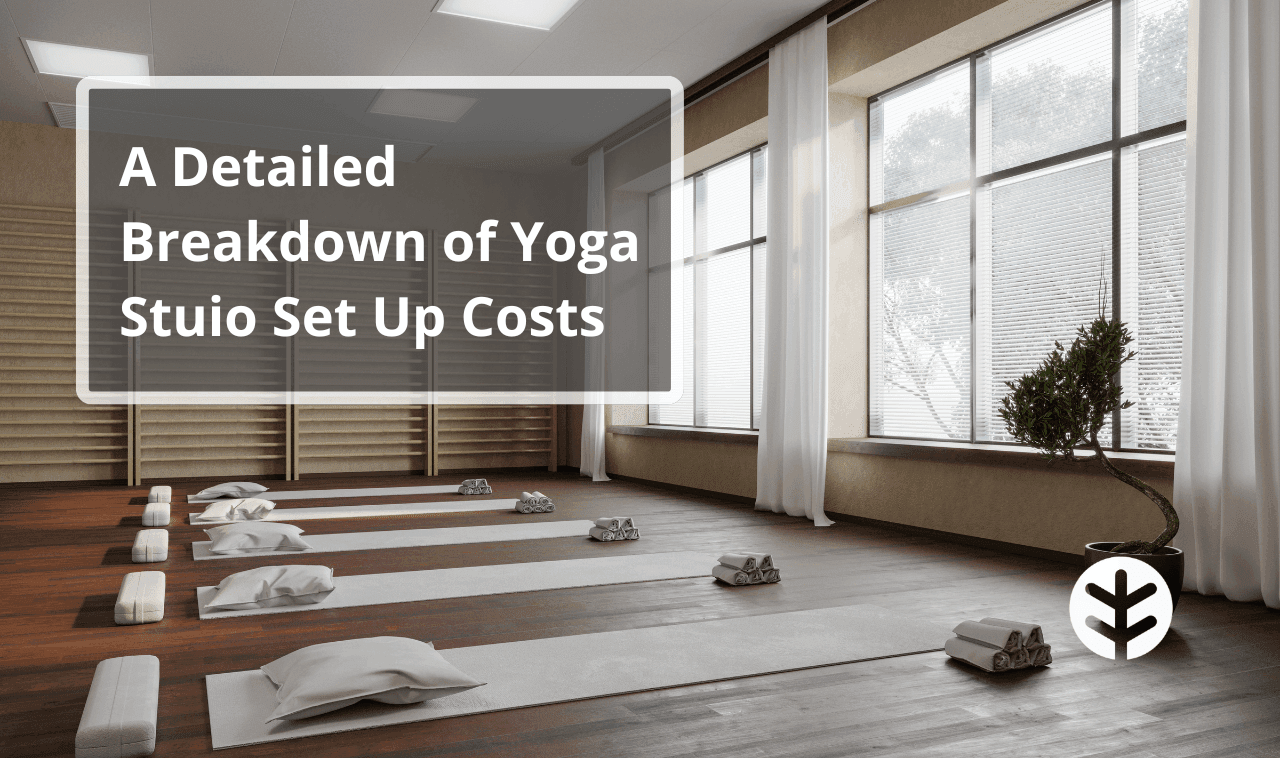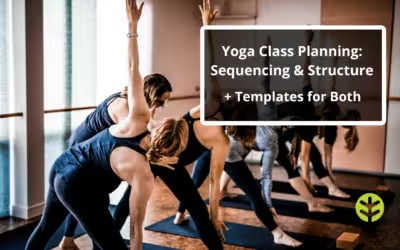You’re thinking about opening a yoga studio. Yoga has profoundly transformed your life, and you dream of sharing its benefits with others.
Perhaps you’re eager for a career change, want to be your own boss, or are excited by the prospect of a new venture. However, you’re understandably concerned. You’ve seen beloved practice spaces close, face a multitude of challenges, and have trepidation about all the yoga studio set up costs involved.
In this blog, we will explore the foundational financial journey of opening and owning a yoga studio to help you determine if this path is right for you.
*All pricing will be presented in USD and approximated based on the most current findable data. Costs and pricing will vary greatly depending on your location, the size of the yoga studio you wish to open, and your goals for the space.
Table of Contents:
- Understanding the Financial Aspect of Starting a Yoga Business
- Initial Costs of Setting Up a Yoga Studio
- Essential Equipment and Furniture Expenses
- Costs Related to Hiring and Staff Management
- Critical Considerations for Your Marketing Budget
- Operational Costs of Running a Yoga Studio
- Tips for Financial Planning and Budgeting
- Tools and Resources for New and Aspiring Yoga Studio Owners
Understanding the Financial Aspect of Starting a Yoga Business
A solid financial plan is vital for achieving goals and securing your yoga studio’s future.
Maintaining a budget prevents overspending, encourages essential savings, and helps manage and reduce debt. It gives you the peace of mind that you’re prepared for everyday needs and unexpected emergencies.
With a clear financial plan, you can make informed decisions that drive growth, ensure stability, and foster success.
Without proper budgeting, you risk overspending, accumulating debt, and needing more savings. This can lead to missed growth opportunities, an inability to prepare for the future, and, most critically, the potential for studio closure.
As you can imagine, this can lead to significant stress and anxiety. A structured financial approach empowers you to navigate obstacles confidently and build a resilient foundation for your yoga business.
According to the U.S. Bureau of Labor Statistics (BLS), around 20% of new small business start-ups fail within the first two years, 45% within the first five years, and 65% within the first ten years.
Critical initial costs to prepare for and corresponding financial goals to meet before starting a yoga business:
- Lease and Renovation Costs: Your biggest expense is securing that perfect location and making it the best space for your studio. Depending on the extent of the renovations required, the studio size, and the lease details (typically paying one to three months upfront), costs vary greatly, ranging from $10,000 to $100,000+.
- Goal: Establish Healthy Credit—A strong credit history is essential for approval of financing, such as a loan, which is likely necessary for most yoga studio owners.
- Yoga Props, Furniture & Tech: When purchasing yoga mats, blocks, bolsters, straps, sound systems, computers, storage units, desks, window dressings, change room lockers, and hooks, etc., expect to spend between $2,000 to $10,000.
- Goal: Create a Detailed Business Plan—Research and create a detailed list of your needs and expenses versus your predicted revenue and accessible start-up revenue. This will help secure necessary funding and guide your spending.
- Operational Expenses: Ongoing expenses require meticulous budgeting and include utilities, insurance, software management, instructor wages, business licenses, and more. They typically range from $1,000 to $20,000+/month.
- Goal: Build a Safety Net—Save or fundraise enough money to cover at least six months of operating expenses. This cushion will help manage unexpected costs and address initial revenue shortfalls.
H4 How Much Do Yoga Studio Owners Make?
Finding a reputable source on a yoga studio owner salary is challenging. Numerous sites suggest the average yoga studio generates around USD 13,500 per month. After accounting for significant expenses, a yoga studio owner makes just over USD 7,000 per month, or approximately USD 84,000-86,000 per year before taxes.
According to Small Business Statistics of 2024, small business owners in the U.S. earn an average salary between $32,000-$147,000. This range, which likely includes yoga studios, highlights the importance of considering all the factors that can significantly influence earnings.
Download OfferingTree's Yoga Studio Business Plan Template
Initial Costs of Setting Up a Yoga Studio
Understanding the initial costs of setting up a yoga studio is vital for creating an inviting, professional, safe space that reflects your brand. Word of mouth is one of yoga studios’ most effective marketing strategies. Investing in these costs ensures an exceptional first impression, encouraging clients to return and bring others along.
Location and Rent
As the old adage goes, “Location, location, location!”
This saying goes beyond tradition—it’s backed by solid evidence linking business success to location. Selecting the right spot is essential for attracting clients, and factors like visibility, accessibility, and comfort are key.
In urban areas near residential neighborhoods, high foot traffic, and density often lead to walk-ins that convert into regular clients. However, being in a city’s downtown core might limit the hours you can offer classes, as people are generally only there during workday hours.
Suburban locations usually have lower costs and ample parking but might have less visibility, which means more effort and money spent on marketing to attract clients.
Your location choice greatly influences your yoga studio’s success and growth.
Rental costs can vary significantly based on city and neighborhood. On average, in the U.S., for a 1,000-square-foot space, you can expect to pay:
- Urban Areas: $2,000 to $10,000+/month
- Suburban Areas: $1,000 to $5,000+/month
For more specific data on rental rates, consider resources such as commercial real estate listings or talking to a local commercial real estate agent to provide the best up-to-date information for the locations that interest you.
Renovation and Interior Design
Creating a calm, inviting atmosphere is essential for attracting and retaining clients. A serene space where students can escape their daily stresses and fully engage in practice helps inspire regular attendance and build a strong community. Every detail counts in a competitive market, both in person and online.
The environment of your studio is more than just a backdrop. It should seamlessly blend functionality and aesthetics to enhance the overall experience for your clients, making it a critical factor in their decision to return.
Understanding the costs involved in creating a welcoming space is crucial. Here are the average prices for common renovation projects, which can vary depending on the size of the space, materials, and labor:
- Flooring: $2-$15/square foot plus installation
- Painting: $0.50 to $4.00/square foot for both materials plus labor
- Lighting: $1000 to $3000 for general and accent lighting, depending on type, number of fixtures, and complexity of installation.
- Creating a Reception Area: $2000-$4000
- Updates to Restrooms & Creating Change Rooms: $2000-$4000
- Storage Areas: $1000-$3000 for props, mat storage, studio supplies
- Heating, Ventilation, Air Conditioning (HVAC): $4000-$8000 *more costly for Hot Yoga Studios
Licenses and Permits
Securing the proper permits and licenses is not just a legal requirement but a crucial step in creating a safe and reliable environment for your yoga studio. These documents ensure compliance with municipal regulations, fostering trust and credibility with your clients.
By having the necessary permits, you demonstrate professionalism and create a safe, reliable environment, which helps build client confidence and contributes to your studio’s smooth operation and success.
The need depends on the laws, location, and activity you provide. They vary from state to state and at the federal level.
According to the US Small Business Administration, the permits and licenses needed to open a yoga studio vary by state, location, and services offered. Therefore, thorough research is imperative to ensure you are fully informed and prepared.
Here is a list of what licenses and permits you may need to open a yoga studio and their varying prices:
- Business License: $50 to $200, mandatory to conduct business.
- Health and Safety Permit: $100 to $500, ensures compliance with local health codes.
- Building Permit: $200 to $2,000 for construction or significant renovations.
- Signage Permit: $50 to $200, required for exterior signage.
- Occupancy Permit: $100 to $1,000 confirms the building meets safety and zoning requirements.
Essential Equipment and Furniture Expenses
Selecting the right props, equipment, and furnishings is key to creating a welcoming environment for your yoga studio. These elements enhance the space and reflect your brand and the atmosphere you want to cultivate.
While investing in high-quality items might be more expensive, remember that you often get what you pay for—premium choices can significantly improve your studio’s overall experience and appeal.
Yoga Mats, Blocks, Straps, Blankets, Etc.
When selecting yoga props for your studio, consider the type of classes you will be offering. For classes that offer meditation, restorative, Iyengar, Yin, and yoga nidra, or classes designed for prenatal, senior, or beginner students, you will need lots of props to support your clientele.
High-quality props are essential because they must withstand frequent use without breaking down or tearing. Investing in long-lasting yoga props reduces the need for frequent repurchases.
Additionally, choose suppliers who offer wholesale discounts for yoga studio owners to keep costs manageable, as you’ll need to replenish these props periodically to maintain a high standard of cleanliness, safety, and comfort in your studio.
- Yoga Mats: $20-$200 each, with options ranging from standard to high-quality and specialty mats offering extra length or cushioning.
- Yoga Blocks: $10-$35 each, available in foam, cork, or wood, with different widths.
- Yoga Straps: $8-$20 each, with variations in length, material, and buckle style.
- Yoga Blankets: $15-$50 each, differing by fabric type, weight, and size.
- Yoga Bolsters: $30-$75 each, available in various quality levels, styles, and sizes.
- Yoga Wheels: $30-$85 each, with options differing in size and quality.
- Backless Yoga Chairs: $50-$150 each, ranging from standard to high-quality, including custom options.
- Anti-Slip Yoga Towels: $10-$70 each, with choices based on absorbency, stickiness, and brand.
- Yoga Headstanders: $100-$150 each, with different brands and styles available.
- Vinyl Covers for Bolsters: $100-$200 each; consider a local seamstress for custom, durable, non-porous covers.
Furniture and Decor
Furniture and decor in a yoga studio could be easy to overlook. Still, every detail counts, from where clients store their belongings—shoes, jackets, and purses—to ensuring their items are secure while they practice.
Decor is a powerful tool to express your yoga business brand and set the tone for your studio. It’s important to be mindful of cultural sensitivity when choosing elements, ensuring that your decor is a respectful reflection of yoga and aligns with your studio’s identity.
Places that need furniture in a yoga studio:
- Reception area
- Changerooms
- Boot room
- Restrooms
- Storage areas
- Retail area
- Snack bar station
Tech Equipment and Software Tools to Support a Yoga Studio
We cannot undersell the importance of investing in high-quality tech equipment and software tools to enhance your yoga studio. A premium sound system ensures clear and enjoyable audio, just as efficient software streamlines transactions.
Yoga Studio Equipment Costs to Consider
You’ll need equipment such as a good sound system, soft lighting, and user-friendly climate control to create a fully functional yoga studio. All of this plays a vital role in enhancing your clients’ sensory experience and comfort.
Typical costs for studio equipment:
- Sound System: $500 – $2,000+
- Lighting: $5,00 – $3,000+
- Climate Control: $2,000 – $8,000+
- Mirrors: $500 – $2,000
- Yoga Props: $200 – $2,000 (mats, blocks, straps, bolsters, etc.)
- Reception Desk: $300 – $1,500
- Storage Solutions: $200 – $1,000 (shelving, cubbies, etc.)
- Cleaning Equipment: $100 – $500 (vacuums, mops, sanitizers, disinfectant)
Yoga Studio Software Costs to Consider
The right software tools help you manage your yoga studio effectively. These tools streamline operations and enhance client experience and loyalty.
Studio software needs and their approximate costs:
- Booking and Scheduling Software: $50 – $200/month
- Studio Management Software: $100 – $300/month
- Marketing Management Software: $50 – $150/month
- All-in-one software solutions, such as Offering Tree, bundled services for a combined cost, often providing a more cost-effective solution. $225/month
Costs Related to Hiring and Staff Management
When budgeting for hiring and staff management, be aware of your local minimum wage and understand that pay rates will vary greatly depending on experience and your needs. Competitive pay is vital for attracting and retaining excellent yoga instructors, friendly and organized front desk staff, and the best possible members for your team.
Hiring Instructors
Yoga studios often conduct auditions to hire yoga instructors, allowing teachers to lead a class and demonstrate their style and confidence.
Studios may also choose instructors based on their community reputation or personal recommendations. Typically, studios do not cover additional training costs, though they might invest in specialized training for areas like prenatal yoga or Yoga Nidra.
Payment models for yoga instructors are not set in stone. Studios have the power to select the one that best fits their needs.
Yoga studio owners should consider whether classes will be offered online as a hybrid option and added to their on-demand library when determining teacher wages. How an instructor is paid depends on their experience and the studio’s location.
Here are some possible payment models for yoga instructors:
- Flat Rate Per Class: $25 to $100
- Base Rate/Class + Per Head Commission: $0-$35 base rate + $1-$5 per person. For example, an instructor could have a $0 base rate, but if 20 people attend the class at a $5 per person commission, they would earn $100 for that class.
- Hourly: $20 to $60/hour, class time, preparation, cleaning, welcoming clients, and other administrative tasks.
- Salary: $2,000 to $5,000/month, full-time instructors, possibly an instructor who is also the studio manager.
- Revenue Share: 20% to 50% of class or membership fees and sales, depending on the studio’s pricing and instructor agreement.
Administrative Staff
Your yoga studio’s smooth operations depend on an efficient administrative team. Here’s a list of administrative roles you have and their average cost, which vary depending on your location and the experience of your hire:
- Front Desk Staff: $12 to $25/hour, responsible for check-ins, scheduling, greeting and assisting clients, general cleaning, sales, and communication with instructors, managers, and owners.
- Studio Manager: $3,000 to $5,000/month, daily operations, manages teachers and staff, tracks finances, payroll, communication with owners, clients communication, customer service, marketing, community relations, and business development.
- Bookkeeper/Accountant: $20 to $50/hour, tracks and manages finances, bookkeeping, taxes, and payroll.
- Marketing Coordinator: $500 to $4,000+/month, manages promotional activities, events, social media, and advertising.
Critical Considerations for Your Marketing Budget
Allocating funds for a marketing plan is essential. In a competitive market, investing in your yoga studio’s visibility is crucial—people need to know about your studio to become clients. Relying on a “build it and they will come” approach isn’t enough to attract and retain customers. A strategic marketing investment ensures that the studio stands out and draws the attention it deserves.
Brand Development
Your brand is not just a label; it’s a powerful tool that can propel your yoga studio to success in a competitive market. It’s the key to conveying your studio’s unique vibe and offerings, helping potential clients quickly understand what you provide and how you meet their needs.
Clear, effective branding makes your studio more enticing by showing potential clients how you fit into their lives and budgets. It streamlines your message, attracting the right people.
While professional branding services offer expert guidance, they can be expensive. Fortunately, many affordable online tools are available for DIY brand development, though they require time and effort. Don’t skimp on branding—it’s essential for standing out and achieving your goals.
Here are some key factors to consider when determining whether to outsource your branding or do it in-house:
- Budget: Can you afford professional branding services, or does DIY fit your budget better?
- Experience and Interest: Do you have a background in branding and design? Does it interest you? If not, a professional may be a better choice.
- Time: Do you have time to take this on and do it effectively? Outsourcing saves time, and you can expect a professional product.
- Goals: If you know what you envision for your studio’s future, but the path there feels complex, input and strategic plans from professionals can help you get there
Download OfferingTree's Step-by-Step Guide to Brand Development
Website Creation and Management
Your website is often the first impression people have of your yoga studio, making it a critical element of your success. A well-managed, professional website builds trust and engages potential clients, offering a visually appealing and highly functional experience. It should reflect the atmosphere of your studio and inspire visitors to explore further.
Whether you design it yourself using platforms like OfferingTree or hire a professional, investing in a secure, well-maintained website is essential for attracting and retaining clients. Depending on design fees, hosting, and maintenance, the cost will vary greatly, but it’s a vital investment in your yoga business.
Typical costs related to website creation and management include:
- Website Design and Development: $1,000 to $10,000+, depending on whether you design your website or outsource the project.
- Domain Registration: $10 – $20/year for your website’s domain name.
- Website Hosting: $50 – $300/year for reliable hosting services.
- Website Maintenance: $0 – $500+/year, depending if managed in-house or outsourced. This includes updates, security, and technical support.
- Professional Photography: $0 – $1,000+ for high-quality images to enhance your site. Try stock photography sites like www.unsplash.com for free images.
Digital Marketing
As a yoga studio owner, digital marketing is an accessible and often affordable way to help make your studio visible in a competitive online environment. On average, digital marketing costs businesses between $51-$10,000/month, depending on many factors, especially size and goals.
It requires time, attention, strategy, and consistency to be done effectively, but digital marketing is no longer optional. It’s necessary in today’s market to attract clients and for your yoga brand to become known. Digital marketing done well helps your studio stand out and reach a broad audience.
Some commonly used digital marketing options:
- Social Media: $0-$2000+/month, depending on whether it is managed in-house or outsourced.
- Paid Advertisements: $200 – $2,000+/month on platforms like Google, Instagram, YouTube, Facebook, etc.
- Search Engine Optimization (SEO): $0 – $1,500+/month optimizes your website’s search rankings, depending on whether it is managed in-house or outsourced.
Local Advertising
Local advertising is a cost-effective way for yoga studio owners to engage with their community and target market. There are many yoga studios, gyms, and offerings to choose from, but people often like to support studios in their own neighborhoods, as convenience is key.
It seems simple and perhaps a little old school, but flyers, posters, and local events are an excellent way to capture the attention of the exact right people in your own backyard. Here are some estimated costs for local advertising initiatives:
- Flyers and posters: $15-250 for design software memberships like Canva memberships and printing costs.
- Local Events: $50-$500 for promotional materials and other resources for street markets and fairs, community open houses, fundraisers, etc.
- Sponsorships: $200 – $1,000 to sponsor local sports teams and events to increase visibility.
- Cross promotion with other local businesses: $0-$25 for printing and promotional materials, a cost-effective way to create relationships and raise visibility. Partner with coffee shops, ice cream stores, flower shops, consignment stores, and restaurants in your community.
Download OfferingTree's Detailed Yoga Studio Marketing Checklist
Operational Costs of Running a Yoga Studio
Operational costs encompass the majority of the expenses of running a yoga studio. They range from rent to utilities, staff and instructor wages, equipment and props, and more. Operational costs have a direct correlation to your studio’s profitability and sustainability.
Understanding these costs and proper budgeting ensures effective expense management so you can focus on the growth and success of your yoga studio.
Utilities and Maintenance
Monthly utilities and maintenance vary depending on location, local rates, studio size, number of rooms, and consumption. Hot yoga studios can lead to higher operational costs, particularly electricity, water, and cleaning.
Here are some expenses to anticipate:
- Electricity and Natural Gas: $400 to $900/month, one of the most significant expenses for yoga studios. According to the U.S. Energy Information Administration, the average commercial electricity rate in the U.S. is 0.13 cents per kilowatt-hour (kWh). Typically, a small business consumes about 6,066 kWh per month.
- Water (Combined Water & Wastewater): $80 – $200/month, calculated on the number of gallons used. According to the United States Environmental Protection Agency, the average commercial rate per 1,000 gallons of water in the U.S. is $12.42. Typically, a small business, like a yoga studio, uses 10,000 gallons of water per month.
- Internet: $50 – $500/month, depending on reliability and speed, which is an important consideration for live streaming and creating on-demand content.
- Phone: $10-$200/month. Many studios have moved away from landlines, but you may want to consider an inexpensive one for receiving messages and reliability. Many small studio owners forward their business calls to their cell phones.
- Cleaning Services: $200 – $600/month, depending on frequency and studio size.
- Heating, Ventilation, and Air Conditioning (HVAC): $50-$200, depending on studio size, number of rooms, and temperature needs (more expensive for hot yoga studios).
Insurance
Having the correct type of insurance to protect your yoga studio is vital. Typically, yoga studios do not pay for their instructor’s professional liability insurance, but there are exceptions. Here are four types of insurance a yoga studio may require and their approximate costs:
- General Liability Insurance: $42/month covers accidents or injuries on the studio premises.
- Commercial Property Insurance: $63/month protects your physical location, equipment, and supplies.
- Professional Liability Insurance: $200 – $1000/year for yoga instructors; cost varies depending on what and who you teach. Protects against claims of negligence related to teaching practices.
- Workers Compensation Insurance: $47/month, work-related illnesses and injuries if you have employees, not contractors.
Miscellaneous Expenses
Miscellaneous, often overlooked, expenses you will encounter when owning a yoga studio:
- Cleaning Service: $25 to $100/hour, depending on the number of cleaners, frequency, size of the studio, number of bathrooms, hot or regular yoga, kids yoga, and cleanliness of the studio space.
- Cleaning Supplies: $50 to $150/month, including disinfectants, vacuums, garbage bags, mops, dusters, cloths, and vacuums.
- Office Supplies: $50 to $200/month, Printing paper, thermal receipt paper, pens, staples, binders, printer ink, and other administrative items.
- Marketing Materials: $50 to $300/month, Promotional and print materials, i.e. posters, flyers, business cards, gift certificates, signage, local grassroots advertising, etc.
- Meetings and Events: $50 to $300/month, Refreshments, team-building activities, special guests, community parties, workshops, teacher and staff appreciation gifts, etc.
- Wear and Tear: $100 to $300/month, maintenance and repair of studio equipment, aesthetics, and furniture.
Tips for Financial Planning and Budgeting
Investing enough money to ensure a thorough hiring process and staff management is integral to a yoga studio’s success. These expenses include salaries, class wages, and possible health benefits. They impact your budget significantly.
A yoga studio owner’s staff and instructors are the talent and service. You cannot cut corners here, but how do you make it fit your budget?
How to Create a Detailed Budget
Similar to managing personal finances, a detailed budget is essential for the financial health of your yoga studio. Tracking expenses and forecasting income will ensure you are prepared for the future and understand what you’re working with.
Use an editable document to create your budget, as it will be constantly in flux. The more up-to-date your budget, the more helpful and realistic it is as a roadmap for managing your studio’s finances.
To create a yoga studio budget, follow these steps:
Step 1
Identify Fixed Costs: Create a complete list of all your recurring expenses, such as rent, utilities, teacher, debt repayment, insurance, and staff salaries.
Step 2
Estimate Variable Expenses: Create an exhaustive list of fluctuating expenses, such as props, supplies, events, meetings, your salary (depending on profits), utilities, taxes, etc.
Step 3
Examine Revenue: Projected income acquired from all revenue sources, such as classes, membership and passes, teacher training, workshops, retail, and snack bar sales. Profit is what is left after fixed costs and variable expenses are subtracted from the total projected revenue.
Step 4
Set Aside Contingency Funds: Allocate a portion of your funds for unexpected costs or emergencies. This will prepare you for the future and give you peace of mind.
Step 5
Review, Review, Review: Monitor and adjust your budget with actual expenses versus the projected budgeted amounts.
Cost-Saving Strategies
You’re trying to create high-quality service for your yoga studio clients but must stay within a strict budget. Here are some practical ways to save money that don’t take away from client experience:
- Go Green: Energy efficiency means lower utility costs. Consider solutions like LED lighting, programmable thermostats, hand dryers in bathrooms, online manuals for teacher training and workshops, and email receipts only.
- Buy Wholesale: negotiate vendor contracts and set up discounts and better ongoing terms with regular suppliers for studio supplies, services, and props.
- Work Exchange Programs: sometimes called Karma service in yoga studios. Students who cannot afford passes will clean or work the front desk in exchange for yoga classes.
- Purchase All-In-One Software: choose software that offers integrated solutions, such as Offering Tree, for scheduling, marketing, analytics, studio management, and video libraries.
- Use Technology: Use free or low-cost software for scheduling and marketing to streamline operations and reduce administrative costs.
Funding Options
For most, setting up a yoga studio will require more financial support than just dipping into savings accounts. Loans, grants, and investors could be the funding options that make your yoga business possible. Each option has different benefits and criteria.
Here is an overview of each funding option:
- Loans: Borrowed funds that accrue interest. They are most accessible to individuals with good credit history. They help cover start-up costs but require regular and immediate repayments and often come with specific criteria.
- Grants are funds you do not have to pay back, usually provided by an organization or the government. They exist to meet a specific need or for a particular purpose, like promoting the development of local small businesses or health initiatives for the community. They are competitive and have extensive application processes.
- Investors: Provide financial and business support and advice in exchange for some level of involvement in your business. This option may lead to high levels of success as investors often have high business acumen. It is especially attractive to those who require substantial funding.
ROI and Break-Even Analysis
Return on investment and break-even analysis provide critical financial information for setting achievable and realistic goals for all business owners, including yoga studio owners.
Return on Investment (ROI) is a calculation that measures the profitability of your investment and is presented as a percentage or ratio. It tells you how much you have earned relative to the amount you invested.
ROI = (Net Profit / Initial Cost of Investment) x 100
Break-Even Point (BEP) determines the level of sales required to cover all fixed and variable costs. It is the point when total revenue equals total costs.
BEP helps identify when your yoga studio will start generating profit by calculating the point at which revenue from classes, memberships, and other services covers all expenses.This analysis allows you to determine how many clients you need to serve per class, week, or month to break even.
To perform a break-even analysis, you must know your fixed costs (rent, utilities, wages, and insurance) and variable costs (supplies, bonuses, and marketing). You must also know your average revenue per customer.
Break-Even Point = Fixed costs / (Revenue per customer − Variable cost per customer)
For example, if your studio’s fixed costs are $10,000 per month, each customer pays $17 per class, and your variable cost per customer per class is $6, you can calculate the break-even point as follows:
So, using the BEP formula:
Break-Even Point = $10,000 / ($17 − $6) = 909 customers per month
This means you need to serve 909 customers each month to cover your costs and break even.
Tools and Resources for New and Aspiring Yoga Studio Owners
This section explores the tools and resources available for yoga studio owners, including software, online communities, books, blogs, forums, and podcasts. These resources aim to streamline operations, improve marketing efforts, and provide valuable insights and support for growing your studio.
Recommended Software
Business management software will be your new best friend as a yoga studio owner. You will be spending a lot of time together, so you will want to choose one that is intuitive, efficient, improves client experience, and provides valuable insights for growth and overall management. The best business management software for a yoga business helps you reduce overall operational costs and avoid burnout.
Recommended software tools include:
- OfferingTree: All-in-one platform for scheduling, website building, payments, and marketing, tailored for wellness professionals.
- Mindbody: Comprehensive business management software for fitness and wellness businesses.
- Zen Planner: Membership management, scheduling, and billing software for fitness studios.
- Acuity Scheduling: Online booking system with reminders and payment processing.
- Wix: Website builder with booking and payment integrations.
- Hootsuite: Social media management platform for scheduling and analyzing posts across multiple platforms.
- Mailchimp: Email marketing platform for creating, automating, and analyzing campaigns.
- Linktree: Tool for creating a shareable link that leads to multiple URLs, ideal for social media profiles.
- Constant Contact: Email marketing and engagement platform with tools for contact management, social media, and website creation.
- SurveyMonkey: Online survey tool for creating, distributing, and analyzing surveys to gather customer feedback and insights.
- QuickBooks: Accounting software for tracking income, expenses, payroll, and generating financial reports.
Check out the top six reasons to choose OfferingTree over Mindbody, as well as reasons to choose it over other alternatives, such as Squarespace and Wix.
Online Communities and Forums
Being a studio owner can feel lonely at times. You’re connected with teachers and staff, but most tough decisions fall on you. Finding an online community of other yoga studio owners may provide the support and valuable insights you seek. Here are some you may find helpful:
- The O.T. Co-operative: OfferingTree’s studio owner’s private online community provides free resources and business support so businesses can thrive. It is a vibrant community and includes free coaching calls, mastermind sessions, and software release news.
- Yoga Studio Owners: A private Facebook group with 3.3K members dedicated to owners of brick-and-mortar yoga studios. This group offers support and an open forum for sharing experiences and advice with fellow studio owners.
- Yoga Studio Owners and Managers: A private Facebook group with 1.6K members focused on sharing insights and support for yoga studio management. Connect with others to discuss challenges and successes in studio management.
- r/Yoga: A subreddit community for yoga enthusiasts, including studio owners, managers, teachers, and practitioners. Engage in discussions, share tips, and connect with a broad audience interested in yoga.
Further Reading and Courses
Your continued enthusiasm and engagement toward your business are not just vital, but empowering as a studio owner. It’s your commitment that will drive your studio’s success.
Here is a list of just some of the incredible resources available for yoga studio owners:
- OfferingTree: OfferingTree provides a range of resources to help you manage and grow your yoga studio effectively. Explore their webinars, blogs, case studies, and more for valuable insights and the most current information on studio management.
- Yoga Business Coach Michael Jay: Host of the podcast Yoga Biz Champ, Michael Jay offers expert advice on creating, growing, and sustaining a successful studio business.
- Mastering the Business of Yoga with Amanda Kingsmith: Includes a podcast, studio owner blog, and book focusing on mastering the business aspects of yoga.
- Yoga Alliance: The largest nonprofit organization representing the yoga community. Members gain access to the Yoga Business Resource Guide, an extensive library created in collaboration with small business experts, academic institutions, and industry leaders.
- Shannon Crow at The Connected Yoga Teacher: Provides yoga business consultation through one-to-one sessions, podcasts, other resources, and courses to help you refine your strategies and skills and achieve your business goals.
- Niki Raga of Limitless Studio: Offers webinars on success planning in the business of yoga, sharing strategies and insights for long-term success through articles, courses, coaching, and helpful templates.
- The Art and Business of Teaching Yoga by Amy Ippoliti: A highly recommended book that offers practical advice on building and maintaining a successful yoga business.
- Udemy: Offers a variety of specific, tailored online courses on yoga and business management to enhance your skills and knowledge.
- Yoga Journal: A longstanding resource featuring articles, tutorials, instruction guides, interviews, and business support-specific yoga and yoga businesses.
- IAP Career College Yoga Studio Owner Course: training in business skills specific to running a yoga studio. It includes business management, marketing strategies, and operational best practices, providing a comprehensive foundation for launching and sustaining a yoga studio.
Grow Your Yoga Studio with Top-Rated Business Software Like OfferingTree
Running a studio is a serious business that requires responsibility and careful planning. By balancing your love for yoga with a thorough understanding of operating a small business, you can create a thriving yoga studio that benefits your clients and supports your bottom line.
Owning a yoga studio is no easy venture, but with heart, determination, and resources, you can make your yoga business dream a reality.
Try OfferingTree free for 7 days or watch a demo with OfferingTree’s all-in-one studio management software. Our platform streamlines everything from scheduling to finances with built-in analytics, helping you make data-driven decisions and turn your dream yoga studio into a reality.








